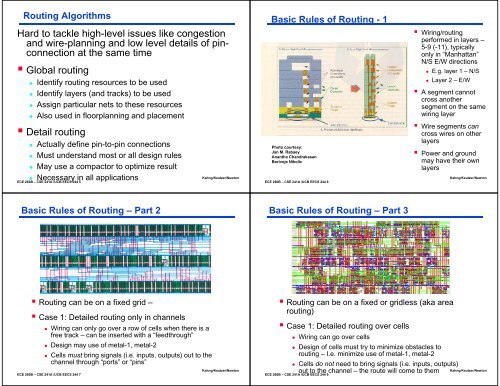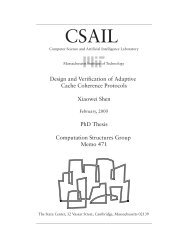RTL Design Flow - Computation Structures Group
RTL Design Flow - Computation Structures Group
RTL Design Flow - Computation Structures Group
You also want an ePaper? Increase the reach of your titles
YUMPU automatically turns print PDFs into web optimized ePapers that Google loves.
Routing Algorithms<br />
Hard to tackle high-level issues like congestion<br />
and wire-planning and low level details of pinconnection<br />
at the same time<br />
Global routing<br />
Identify routing resources to be used<br />
Identify layers (and tracks) to be used<br />
Assign particular nets to these resources<br />
Also used in floorplanning and placement<br />
Detail routing<br />
Actually define pin-to-pin connections<br />
Must understand most or all design rules<br />
May use a compactor to optimize result<br />
Basic Rules of Routing - 1<br />
Photo courtesy:<br />
Jan M. Rabaey<br />
Anantha Chandrakasan<br />
Borivoje Nikolic<br />
Necessary in all applications Kahng/Keutzer/Newton<br />
ECE 260B – CSE 241A /UCB EECS 244 5<br />
ECE 260B – CSE 241A /UCB EECS 244 6<br />
Basic Rules of Routing – Part 2<br />
Routing can be on a fixed grid –<br />
Case 1: Detailed routing only in channels<br />
Wiring can only go over a row of cells when there is a<br />
free track – can be inserted with a “feedthrough”<br />
<strong>Design</strong> may use of metal-1, metal-2<br />
Cells must bring signals (i.e. inputs, outputs) out to the<br />
channel through “ports” or “pins”<br />
ECE 260B – CSE 241A /UCB EECS 244 7<br />
Kahng/Keutzer/Newton<br />
Basic Rules of Routing – Part 3<br />
ECE 260B – CSE 241A /UCB EECS 244 8<br />
Wiring/routing<br />
performed in layers –<br />
5-9 (-11), typically<br />
only in “Manhattan”<br />
N/S E/W directions<br />
E.g. layer 1 – N/S<br />
Layer 2 – E/W<br />
A segment cannot<br />
cross another<br />
segment on the same<br />
wiring layer<br />
Wire segments can<br />
cross wires on other<br />
layers<br />
Power and ground<br />
may have their own<br />
layers<br />
Routing can be on a fixed or gridless (aka area<br />
routing)<br />
Case 1: Detailed routing over cells<br />
Wiring can go over cells<br />
<strong>Design</strong> of cells must try to minimize obstacles to<br />
routing – I.e. minimize use of metal-1, metal-2<br />
Cells do not need to bring signals (i.e. inputs, outputs)<br />
out to the channel – the route will come to them<br />
Kahng/Keutzer/Newton<br />
Kahng/Keutzer/Newton

















